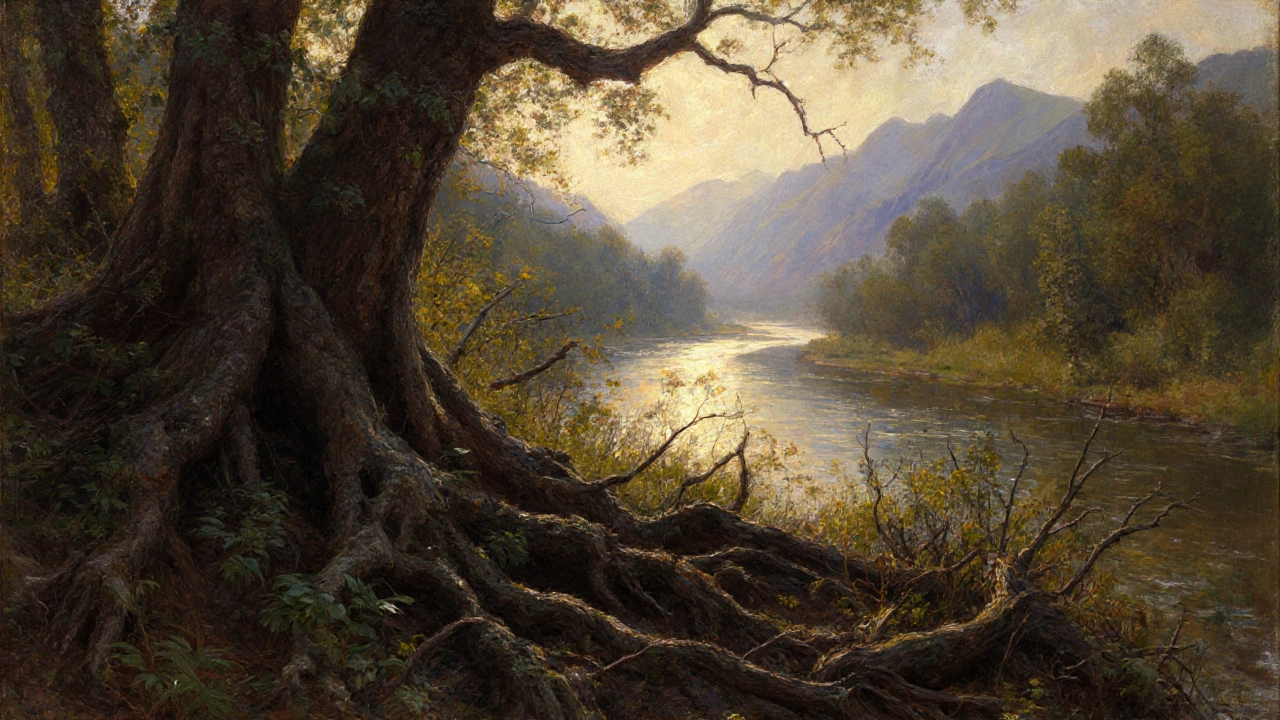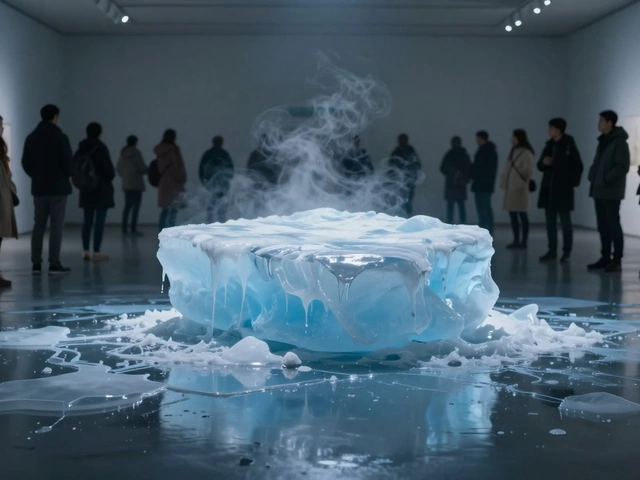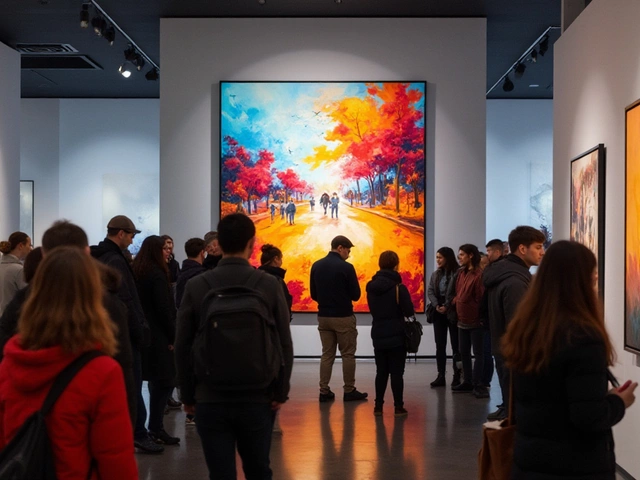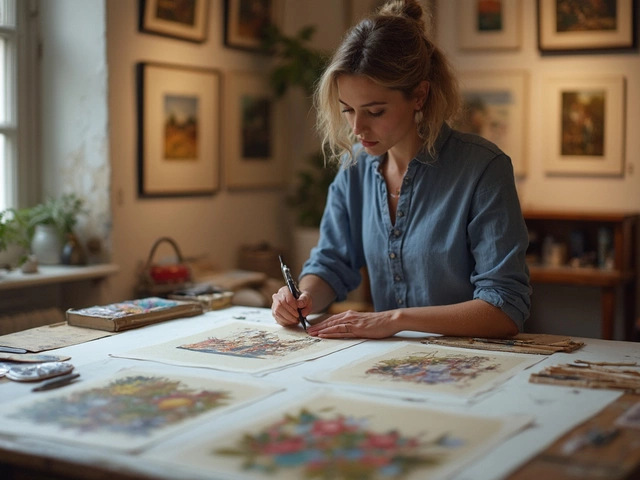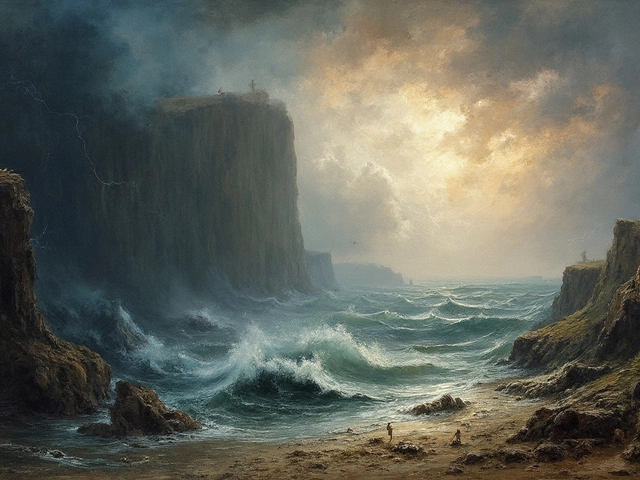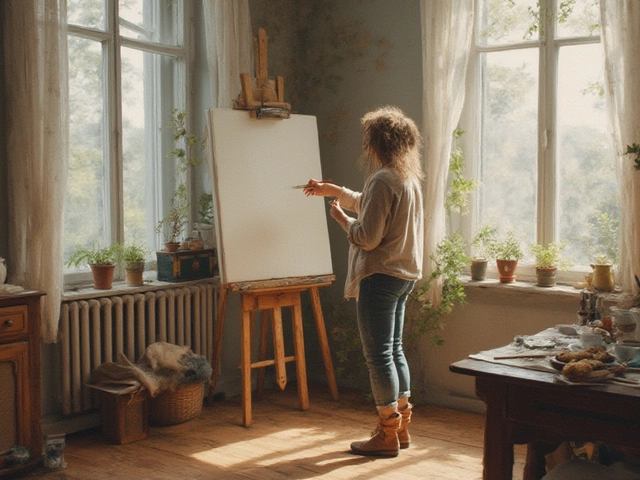Atmospheric Perspective Visualizer
Adjust the sliders below to see how the three components of landscape painting (foreground, middle ground, background) interact to create depth perception. Notice how changing contrast, saturation, and edge sharpness simulates the atmospheric perspective artists use to make distant objects appear far away.
How This Works
In real life, distant objects appear less distinct due to atmospheric particles. Landscape painters replicate this with:
Foreground: High contrast, saturation, and detail
Middle Ground: Moderate contrast/saturation
Background: Low contrast, saturation, and blurred edges
This is called atmospheric perspective and is essential for creating the illusion of depth.
Practical Tips
- Foreground: Use dark colors and sharp details to anchor the viewer
- Middle Ground: Place focal point here to guide the eye
- Background: Reduce detail and use cooler colors to create distance
- Consistency: Maintain the same contrast/saturation gradient throughout the piece
What You're Seeing
Foreground: Full detail, strong colors
Middle Ground: Moderate detail and color
Background: Minimal detail, pale colors
When you look at a great landscape painting, it doesn’t just show you a view-it pulls you into it. You feel the distance between the trees up close and the mountains far away. You sense the air between the rocks and the sky. That feeling doesn’t happen by accident. It’s built on three simple, powerful parts: the foreground, the middle ground, and the background. These aren’t just fancy terms. They’re the bones of every successful landscape painting, from 18th-century European works to modern watercolors painted in the Pacific Northwest.
Foreground: The Closest View, the Strongest Impact
The foreground is what’s closest to you-the part of the scene you’d step into first. It’s the rocks at your feet, the grass brushing against your boots, the fallen branch half-buried in dirt. In a painting, this area grabs attention. Artists use it to lead your eye inward. Without a strong foreground, a landscape feels flat, like a photo cut out and stuck on a wall.
Think of the work of Thomas Cole, one of the founders of the Hudson River School. In his 1836 painting The Oxbow, the foreground is thick with wild vegetation, twisted roots, and dark, broken tree trunks. It’s messy, alive, almost chaotic. That contrast makes the calm, glowing river and distant mountains behind it feel even more peaceful. The foreground isn’t just decoration-it’s the anchor.
Practical tip: Use texture and detail here. Paint individual blades of grass, rough bark, pebbles. Make the colors darker and more saturated. Warm browns, deep greens, rich umbers. This creates depth. The more you define the foreground, the more the viewer feels like they’re standing in the scene.
Middle Ground: The Storyteller of the Scene
The middle ground is where the action happens. It’s the space between your feet and the horizon. Here, you find the main subject of the painting-the stream winding through the valley, the cabin tucked into the trees, the path leading toward the distance. This is the part that tells the story.
In John Constable’s Salisbury Cathedral from the Meadows, the middle ground holds the road, the herd of cattle, and the distant cathedral. It’s not the brightest part, but it’s the most important. Without it, the painting would just be a pretty sky and some trees. The middle ground connects the foreground to the background. It gives the viewer a place to rest their eyes before moving deeper into the scene.
Artists often use the middle ground to create movement. A winding river, a row of trees, a trail-all of these guide the eye. You don’t just look at the middle ground; you follow it. That’s why many landscape painters place their focal point here. It’s the emotional center of the piece.
Tip: Keep this area less detailed than the foreground but more defined than the background. Use softer edges and slightly lighter tones. If the foreground is deep green, the middle ground might be a muted olive. If the foreground has sharp shadows, the middle ground lets them fade.
Background: The Atmosphere, Not Just the Sky
The background is often misunderstood. Most people think it’s just the sky. But it’s so much more. It’s the farthest hills, the haze over the valley, the mountains melting into clouds. It’s where the world ends and the air begins.
Look at any painting by J.M.W. Turner. His backgrounds aren’t just painted-they’re breathed. He used thin glazes of color, barely there washes of blue, gray, and pink, to suggest distance. The mountains in his work aren’t sharp. They’re suggestions. That’s the key: the background loses detail, color, and contrast. It’s lighter, cooler, and softer.
This isn’t laziness. It’s science. In real life, the farther away something is, the more atmosphere gets between you and it. Dust, moisture, and light scatter color. Blue light travels farther, so distant things turn bluish. That’s why mountains look blue on a clear day. Landscape painters call this atmospheric perspective.
Use this rule: background = less contrast, less saturation, less detail. Paint distant trees with a single stroke. Let the sky blend into the hills. Don’t outline the far peaks. Let them dissolve. This creates depth without trying. The viewer’s brain fills in the rest.
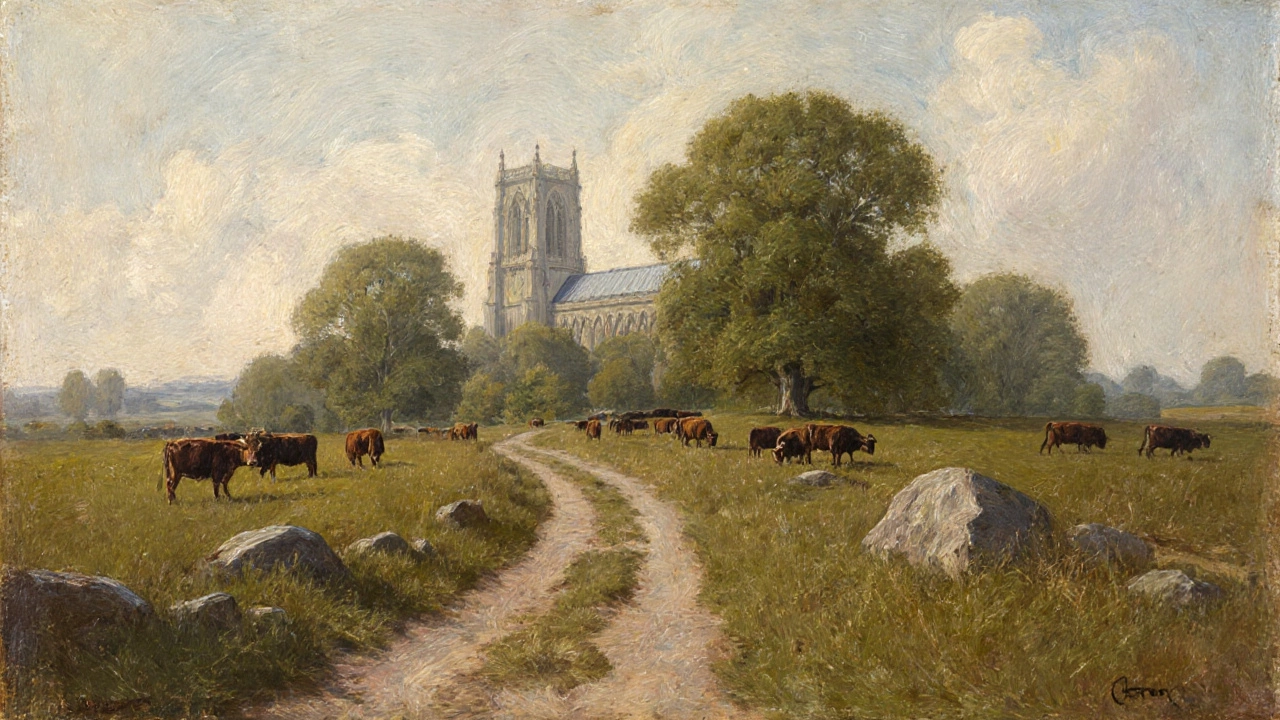
How the Three Work Together
These three parts don’t exist in isolation. They rely on each other. A strong foreground makes the background feel distant. A soft background makes the foreground feel real. The middle ground is the bridge.
Try this exercise: Take a photo of a landscape and draw three horizontal lines across it. One at the bottom third-that’s your foreground. One at the middle third-that’s your middle ground. The top third? Background. Now, look at how the elements fall into place. You’ll see how even amateur photos follow this structure.
Many beginners make the mistake of treating all parts the same. They paint every tree with the same detail. Every rock with the same shadow. The result? A flat, confusing mess. A good landscape painting has rhythm. It moves. It breathes. That rhythm comes from the balance between near and far, sharp and soft, dark and light.
Common Mistakes to Avoid
- Putting the main subject in the background. If your cabin is way up in the hills with no path leading to it, viewers won’t find it. Place it in the middle ground.
- Overdoing the foreground. Too many rocks, too many leaves, too much detail-it overwhelms. Let the foreground guide, not crowd.
- Ignoring atmospheric perspective. If your distant mountain is the same color and sharpness as the tree in front of it, the painting loses depth. Cool it down. Lighten it. Blur it.
- Forgetting the sky. The sky is part of the background. Don’t just leave it white. Add subtle gradients, hints of cloud, the faintest blush of dawn or dusk.
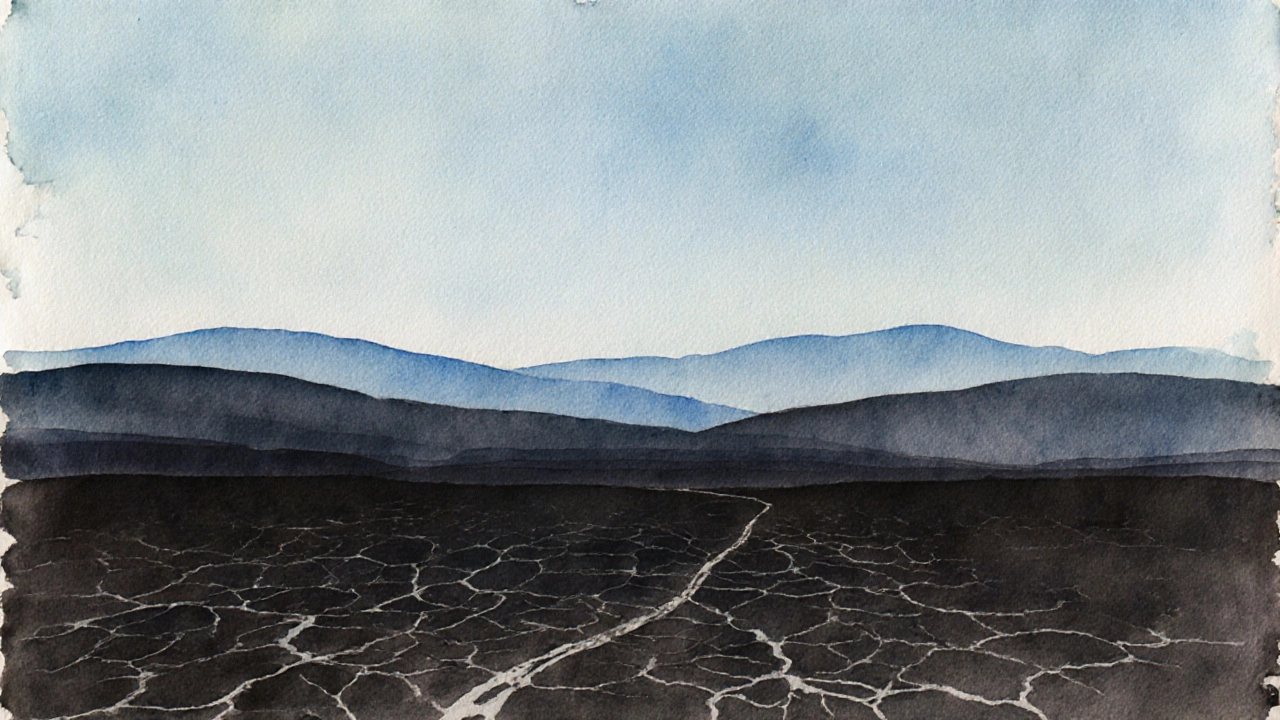
Real-World Examples
Look at a painting by Georgia O’Keeffe’s Black Place. The foreground is cracked earth, dark and textured. The middle ground holds low, rolling hills with a faint path. The background? A vast, pale sky that fades into the horizon. No trees, no birds-just space. It’s minimal, but powerful because each layer does its job.
Or consider a simple watercolor by an unknown artist in British Columbia. A muddy trail in the foreground, a stand of fir trees in the middle, and snow-capped peaks in the background, washed in pale blue. No grand title. No famous name. Just three layers, perfectly balanced.
Putting It All Together
Start with your background. Sketch the horizon line. Decide how far away your mountains or hills will be. Then, place your middle ground-what’s the story? A river? A cabin? A path? Then come back to the foreground. What’s under your feet? Grass? Rocks? A fallen log? Layer them in. Don’t paint everything at once. Build from back to front.
Remember: you’re not just painting a scene. You’re creating an experience. The foreground invites you in. The middle ground holds your interest. The background lets you breathe. Together, they make a landscape feel alive.
What is the most important component in landscape painting?
There isn’t one single most important part-it’s the balance between all three. But if you had to pick, the middle ground usually carries the main subject and tells the story. Without it, the painting lacks focus. However, without a strong foreground and atmospheric background, the scene feels flat. All three must work together.
Can you have a landscape painting without a foreground?
Technically, yes-but it won’t feel immersive. Paintings without a foreground, like some aerial views or distant mountain scenes, often feel like postcards. They’re beautiful, but they don’t pull you in. Most viewers connect with art when they feel like they could step into it. A foreground, even a small one, creates that sense of presence.
How do I make the background look far away?
Use atmospheric perspective. Reduce contrast-don’t make dark shadows in distant hills. Lower saturation-use muted blues, grays, and lavenders instead of bright greens. Soften edges-blur outlines with a dry brush or light wash. And lighten the value-distant objects are always lighter than nearby ones. This tricks the eye into seeing depth.
Why do some landscape paintings look flat?
They usually treat all areas the same. If every tree, rock, and hill is painted with the same level of detail and color intensity, the eye has no place to rest or move. Depth comes from contrast: sharp vs. soft, dark vs. light, detailed vs. blurred. Without those differences, the painting loses dimension.
Do I need to paint all three components in every landscape?
Almost always, yes. Even minimalist landscapes have implied layers. A single tree against a sky still has a foreground (the ground beneath it), a middle ground (the tree itself), and a background (the sky). If you leave out one, the composition feels incomplete. The eye expects that structure. It’s how we naturally see the world.
Next Steps for Your Painting
Grab a sketchbook. Go outside-anywhere with a view, even a backyard. Look at the scene and identify the three layers. Sketch them quickly. Don’t worry about detail. Just mark where the foreground ends, the middle ground begins, and the background fades. Do this five times. You’ll start seeing landscapes differently. Not as a single image, but as a layered experience. That’s when your paintings begin to breathe.
